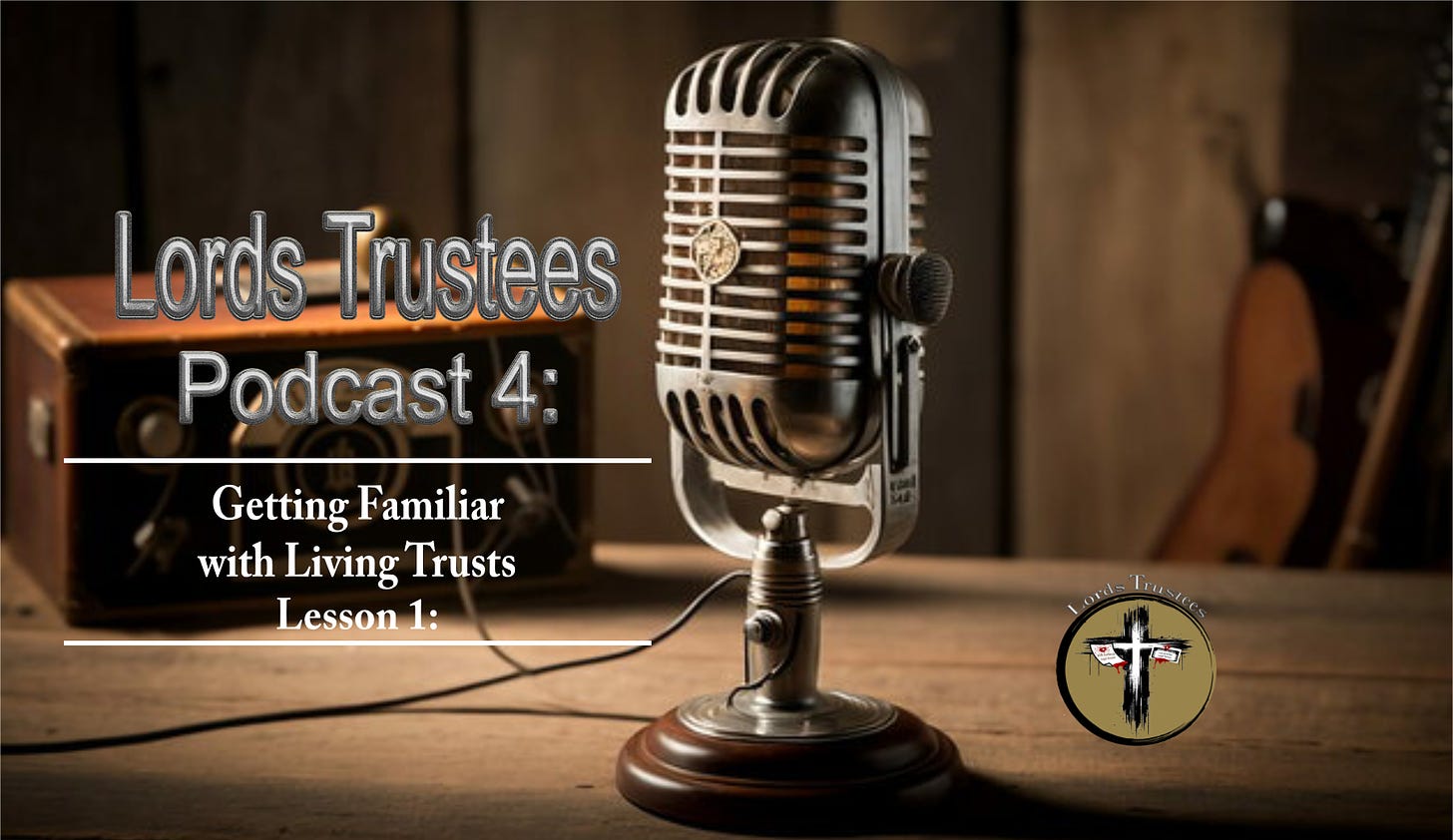Lords Trustees Podcasts are segmented into 2 portions. First part is a presentation on metaphysical studies, followed by a presentation in applying the metaphysical precepts to private living. For those that prefer to listen, there is a video of the podcast at the beginning of each post. Posted below the video, readers may scroll down to find the notes for both parts associated with this podcast. Enjoy!
This Week’s Video Podcast #4
Lesson 1: Getting Familiar with Living Trusts in detail.
Objective:
By the end of this lesson, students will have a foundational understanding of what living trusts are, why they are important in estate planning, and the roles of the key players involved.
________________________________________
1. Introduction to Living Trusts
• What is a Living Trust?
o A living trust is a legal document created by an individual, known as the trustor or grantor, during their lifetime. This trust holds the title to the trustor’s assets and provides clear instructions on how those assets are to be managed during their life and distributed after death.
o The trust can be either revocable or irrevocable. In a revocable trust, the trustor retains control and can modify or dissolve the trust at any time. An irrevocable trust cannot be easily changed once it is established, providing benefits such as asset protection and tax savings.
• Why Are Living Trusts Important?
o Avoiding Probate: Assets placed in a living trust bypass the probate process, which can be lengthy, expensive, and public. This ensures a quicker and more private transfer of assets to beneficiaries.
o Asset Management During Incapacity: If the trustor becomes incapacitated, the trustee can step in to manage the trust assets according to the trustor’s instructions, ensuring that the trustor’s financial affairs are handled smoothly.
o Privacy: Unlike a will, which becomes a public record after death, a living trust remains private, protecting the details of your estate from public view.
2. Types of Living Trusts
• Revocable Living Trusts:
o The most common type of living trust.
o The trustor maintains full control over the trust, including the ability to modify, add, or remove assets, and revoke the trust entirely if desired.
o Provides flexibility in estate planning, allowing the trustor to adapt the trust to changing circumstances.
• Irrevocable Living Trusts:
o Once established, an irrevocable trust generally cannot be altered or revoked by the trustor.
o Assets transferred to an irrevocable trust are removed from the trustor’s taxable estate, offering potential tax benefits.
o Provides protection from creditors and lawsuits, as the trustor no longer owns the assets in the trust.
________________________________________
3. Roles and Responsibilities in a Living Trust
• Trustor (Grantor):
o The individual who creates the trust and transfers their assets into it.
o Responsible for defining the terms of the trust, including how the assets should be managed and distributed.
• Trustee:
o The person or institution responsible for managing the trust according to the trustor’s instructions.
o The trustor often serves as the initial trustee of a revocable trust, with a successor trustee named to take over upon the trustor’s death or incapacity.
o The trustee has a fiduciary duty to act in the best interests of the beneficiaries.
• Beneficiaries:
o The individuals or entities that will receive the assets from the trust.
o The trustor can specify when and how the beneficiaries will receive their inheritance (e.g., upon reaching a certain age, in installments, or upon the occurrence of a specific event).
________________________________________
4. Benefits of a Living Trust
• Avoiding Probate:
o Probate is a legal process that verifies a will and oversees the distribution of an estate. It can be time-consuming and costly. A living trust avoids probate, enabling assets to be transferred directly to beneficiaries.
• Incapacity Planning:
o If the trustor becomes incapacitated, the successor trustee can immediately step in to manage the trust, avoiding the need for court-appointed guardianship or conservatorship.
• Privacy:
o A living trust does not become a public document upon the trustor’s death, keeping the details of the estate and its distribution private.
• Flexibility:
o A revocable living trust offers the trustor the ability to adjust the trust as circumstances change, providing ongoing control and flexibility.
________________________________________
Activities:
1. Review and Discussion of a Sample Living Trust Document:
o Examine a sample living trust document to identify key components such as the trust agreement, designation of trustees, and instructions for asset distribution.
o Discuss how the sample trust provides for the trustor’s wishes and the protection of beneficiaries.
2. Q&A on the Importance of Living Trusts in Estate Planning:
o Students will be encouraged to ask questions and share their thoughts on why they think living trusts might be valuable for estate planning.
________________________________________
Assessment:
• Short Quiz:
o Questions will cover the roles within a living trust (trustor, trustee, beneficiary) and the primary benefits of establishing a living trust.
Sample Quiz Questions:
1. What is a living trust, and how does it differ from a will?
2. What are the main advantages of a revocable living trust?
3. Who typically serves as the trustee in a revocable living trust?
4. Explain how a living trust can help avoid probate.
5. What is the primary difference between a revocable and an irrevocable trust?
Go To Lesson 2: Debunking Common Living Trust Misconceptons




